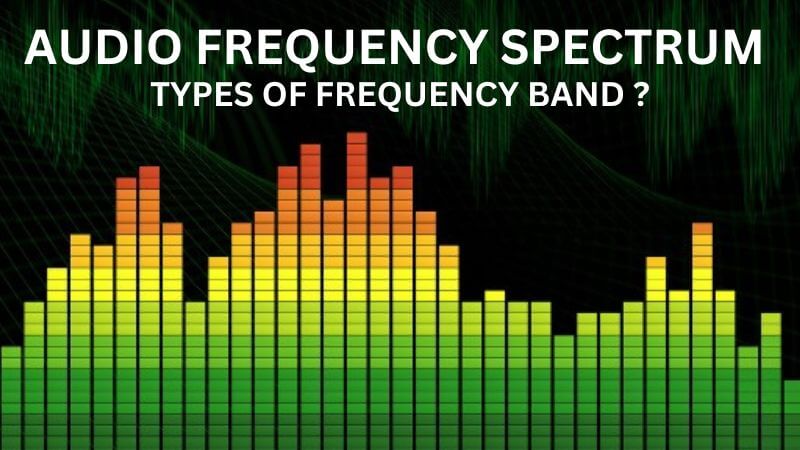- You have no items in your shopping cart
- Subtotal: $0.00

[ad_1]
If you want to talk about audio, you need to know the different components of sound. By components, we mean sub-bass, bass, midrange, treble, and brilliance. You will find these components mentioned in any audio device specifications and features. To understand the different components of sound, you need to know the frequency range that these components fall into.
That’s where the audio frequency spectrum comes into the picture. Understanding the audio frequency spectrum and its distribution among all components is essential if you want to become an audio geek. It is equally useful in understanding various technical details of audio. Besides, it is necessary to understand the audio frequency spectrum if you want to understand different audio equalizers.
What is the Audio Frequency Spectrum?
To understand the audio frequency spectrum, you must first understand frequency. Any sound makes air molecules vibrate, and these vibrating molecules hit our eardrums. The number of vibrations per second is measured in terms of frequency.
The audio frequency spectrum refers to the range of frequencies that the human ear can hear correctly. The range starts from 20Hz and ends at 20,000Hz. For audio devices, this audio frequency spectrum is divided into seven different frequency bands. Each of these bands has a different sound quality.
What Are the Different Audio Frequency Bands?
Although the audible frequency range for the human ear is from 20Hz to 20kHz, different people have different audible frequency ranges. It depends on the subject’s age to some extent. Some of us hear higher frequencies better and cannot hear lower frequencies, and vice versa.
Frequencies close to 20 Hz are considered very deep, and they are almost inaudible to human ears. They are felt more than heard because of the intense vibration at lower frequencies. Frequencies around 20 Khz are extremely high and can cause hearing loss. Some consider that sound to be noise.
The audio frequency spectrum is broadly divided into seven categories. Let us understand the different audio frequency bands in detail.
1. Sub-Bass (20Hz – 60Hz)
Sub-bass is the deepest sound the human ear can hear. The sub-bass is more felt than heard. This is because sub-bass is more about vibration than actual sound. Because of the higher vibration, the sound is powerful and impactful. This is why most acoustic instruments cannot produce sub-bass. There are some instruments like bass guitar, harp and bass trombone that specialize in producing sub-bass. Audio with only sub-bass boost will not sound good continuously.
2. Bass (60Hz – 250Hz)
The bass range is wider than the sub-bass. Similarly, many acoustic instruments produce bass compared to sub-bass. In fact, you will find modern songs with a large amount of bass that makes it full and rich to human ears. To be more specific, modern songs focus on 90 Hz to 200Hz. There are several popular instruments such as trumpet, saxophone, guitar, violin, and cymbals that produce bass audio. Even male and female voices can produce bass. Audio with bass boost can produce a boomy sound that can also be unpleasant.
3. Low Midrange (250Hz – 500Hz)
The low midrange produces low tones that most musical instruments can handle. Both male and female human voices can easily produce a low midrange sound. You can hear these low tones clearly and some bass is present in the lower midrange. If you boost the low midrange reasonably, the sound will be clearer. But if you increase it too much, the sound will be muffled.
4. Midrange (500 Hz – 2000 Hz)
The most important part of most modern songs is the midrange. It is important to make a general impression. Musical instrument players can tweak the midrange tones to make the sound more prominent. The middle of a musical instrument makes the sound of the instrument appear between the tones of all the instruments in a song.
5. Upper Midrange (2000Hz – 4000Hz)
The upper midrange is responsible for carrying the rhythm of a song. You can see the percussion making the upper midrange. Selected musical instruments produce the upper midrange with a slight boost. But if the boost is too much, it can become tiring to listen to. The high midrange is usually suitable for vocals because such vocal sounds are very noticeable.
6. Low Treble (4000 Hz – 6000 Hz)
The lower treble is called Presence. Tones produced in the lower treble improve sound clarity. But when the low treble is raised, it’s very loud. Therefore, it should be absolutely perfect without any improvement for its remote property. You can see the violin and piccolo making a perfect low treble.
7. Light (6000 Hz – 20000 Hz)
Brilliance is also called Highs. Few instruments can achieve sound in this high frequency range. Brilliance adds a freshness to any sound but making it more difficult. If you increase the brightness, it can cause distortion and hissing sound. Such a voice may not be very pleasant. Certain percussion instruments, such as cymbals, fall into this category.
Table of Audio Frequency Spectrum
| Frequency Band | Quantity Range |
| Sub-bass | 20 to 60 Hz |
| Bass | 60 to 250 Hz |
| Lower Midrange | 250 to 500 Hz |
| Midrange | 500 Hz to 2 kHz |
| Upper Midrange | 2 to 4 kHz |
| Low Treble | 4 to 6 kHz |
| LIGHT | 6 to 20 kHz |
Conclusion
If you talk about sound and musical instruments, and you want to understand frequency details, you need to know about the audio frequency spectrum. The audible frequency range is divided into seven bands, and each band adds a unique property to a sound. You can find these bands in the specifications of speakers, microphones, amplifiers, instruments, and various audio gadgets.
[ad_2]
Source link



